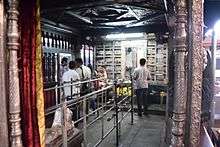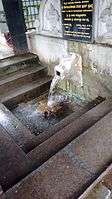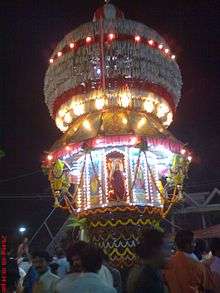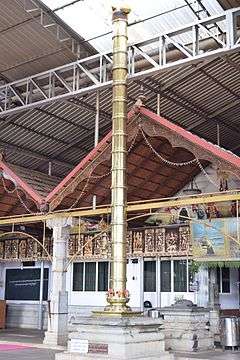Mangaladevi Temple
| Mangaladevi Temple | |
|---|---|
|
Statue of Mangaladevi inside the temple | |
 Mangaladevi Temple Location in Karnataka | |
| Geography | |
| Coordinates | 12°50′57″N 74°50′43″E / 12.84917°N 74.84528°ECoordinates: 12°50′57″N 74°50′43″E / 12.84917°N 74.84528°E |
| Country |
|
| State |
|
| District | Dakshina Kannada |
| Locale | Bolar, Mangalore |
| Culture | |
| Primary deity | Mangaladevi |
| Important festivals | Dasara |
| Architecture | |
| Architectural styles | Kerala architecture |
| History and governance | |
| Date built | 9th Century AD |
| Website | http://www.mangaladevitemple.com/ |

The Mangaladevi Temple is a Hindu temple at Bolara in the city of Mangaluru in the South Indian state of Karnataka, situated about three km southwest of the city centre. The temple is dedicated to Hindu god Shakti in the form of Mangaladevi. The city of Mangaluru is named after the presiding deity, Mangaladevi. The temple is of significant antiquity and is believed to have been built during the 9th century by Kundavarman, the most famous king of the Alupa dynasty during the 9th century under the aegies of Matsyendranath. As per another legend, the temple is believed to have been built by Parashurama, one of the ten avatars of Hindu god Vishnu and later expanded by Kundavarman.
The temple is built in Kerala style architecture, which is common in all temples in the South Indian state of Kerala and Western Ghats, with most of its structure made of wood. The presiding deity, Mangaladevi in the central shrine is in a seated posture. There are shrines around the sanctum for other deities.
In modern times, the temple is maintained and administered by hereditary trustees. The temple is open daily from 6 a.m to 10 am, 12 pm to 1 pm and 4 pm to 8 pm.
Etymology
Mangalore was named after the Hindu deity Mangaladevi, the presiding deity of the temple[1] or a synonym of Tara Bhagvati of the Vajrayana Buddhist sect.[2] According to local legend, a princess from Malabar named Parimala or Premaladevi renounced her kingdom and became a disciple of Matsyendranath, the founder of the Nath tradition. Having converted Premaladevi to the Nath sect, Matsyendranath renamed her Mangaladevi. She arrived in the area with Matsyendranath, but had to settle near Bolar in Mangalore as she fell ill on the way. Eventually she died, and the Mangaladevi temple was consecrated in her honour at Bolar by the local people after her death.[3] The city got its name from the temple.[4]
Legend

The temple dates back to the ninth century when Kundavarman, the most famous king of the Ahepa dynasty, was ruling Tulu Nadu. During this period, there were two holy saints of the Nath cult, Machindranath and Gorakhnath, who came from Nepal. They reached Mangalore, crossing the river Nethravathi. The place where they crossed the river came to be known as Gorakdandi. They chose a place near the banks of the Netravathi which was once the centre of activities of the sage Kapila. The ruling king met the two saints. Pleased with the humility and virtues of the king, they informed him that his kingdom needed to be sanctified with a temple for Mangaladevi. From their own mother he heard the story of Vihasini and Andasura, Parashurama and the temple built by them. The two saints took the king to the sites where all these historical events had taken place. They asked the king to dig the place and relieve the lingam and the dharapatra symbolising Mangaladevi and install them in a shrine along with Nagaraja for providing protection. Kundavarman built grand shrine to Mangaladevi was built on the hallowed place with the guidance of the sages. Even today the two temples of Mangaladevi and Kadri, Mangalore have maintained their connection. The hermits of Kadri Yogirajmutt visit Mangaladevi temple on the first days of Kadri temple festival and offer prayer and silk clothes.[5]
As per another legend, the temple is believed to have been built by Parashurama, one of the ten avatars of Hindu god Vishnu. During the passage of time, the temple was covered by vegetation and was restored by Kundavarma of Alupa dynasty during the 9th century.[5] There are also views that the temple was built by Ballal family of Attavar to commemorate a Malabar Princess.[6]
The temple
The temple is built in Kerala style architecture, which is common in all temples in the South Indian state of Kerala and Western Ghat. The temple has a two storeyed gopuram or a gateway tower, with the upper storey having wooden trails covering the Kottupura (a hall of drum beating during festivals). A rectangular wall around the temple, called Kshetra-Madilluka piereced by the gateways, encloses all the shrines of the temple. The metal plated flagpost or Dwajasthambam is located axial to the temple tower leading to the central sanctum. The central shrine called Sreekovil houses the image of the presiding deity. It is on an elevated platform with a single door reached through a flight of five steps. Either sides of the doors have images of guardian deities called Dvarapalakas. .[7]
The central shrine has a circular plan with the base built of granite, superstructure built of laterite and conical roof made of terrocata tile supported from inside by a wooden structure. The central shrine is at a lower elevation, with a shrine of Nagar, the snake god, in the elevation. Mangaladevi is depicted in sitting posture as Dharapatra. There is a small Lingam to the left of the icon.[8][9] In modern times, the temple is maintained and administered by hereditary trustees. The temple is open daily from 6 a.m to 10 am, 12 pm to 1 pm and 4 pm to 8 pm.
Festivals

Navaratri (dussera) is the time for special pujas performed on all nine days. On the seventh day, Goddess Mangaladevi is worshipped as Chandika (or Marikamaba), on the eighth day the goddess is worshipped as Maha Saraswathi. On the ninth day which is also known as Mahanavmi goddess is worshipped as Vagdevi, goddess for speech, Aayuda puja is performed. All the weapons and tools are worshipped as the day marks the slaying of the cruel demons by the goddess Durga, and Chandika yaga are also performed on this day. A large number of devotees participate in the Rathothsava on the tenth day, which is celebrated as Dussera. The decorated goddess in mounted on the grand chariot and pulled with thick ropes, the procession goes to Marnamikatte where the goddess and the Shamivriksha are worshipped.[10]
References
- ↑ Kameshwar, G. (2004). Tulu tales: a soota chronicle. Rupa & Co. p. 8. ISBN 978-81-291-0427-4.
- ↑ Sadasivan, S.N. (2000). A social history of India. New Delhi: APH Pub. Corp. pp. 207–208. ISBN 81-7648-170-X.
- ↑ Venkataraya Narayan Kudva (1972). History of the Dakshinatya Saraswats. Samyukta Gowda Saraswata Sabha. p. 260.
- ↑ Temple India. Vivekananda Prakashan Kendra. 1981. p. 160.
- 1 2 Atmashraddhananda, Swami (2015). A Pilgrimage to Western Ghats Temples - Karnataka. Lulu Press, Inc. pp. 87–88. ISBN 9781312918191.
- ↑ Sewell, Robert (1882). Lists of the Antiquarian Remains in the Presidency of Madras, Volume 1. E. Keys. p. 234.
- ↑ Cultural Heritage of Kerala. Kerala, India: DC Books. 2008. p. 139. ISBN 9788126419036.
- ↑ R., Krishnamurthy (21 May 2015). "In the lap of the Western Ghats". The Hindu. Retrieved 23 August 2015.
- ↑ Subodh Kapoor, ed. (2002). The Indian Encyclopaedia: Kamli-Kyouk Phyu. 13. Genesis Publishing Pvt Ltd. p. 3963. ISBN 9788177552577.
- ↑ "Rathotsava at Mangaladevi draws large crowd". Mangalorean. 21 March 2009. Retrieved 23 August 2015.
External links
| Wikimedia Commons has media related to Mangaladevi Temple. |
